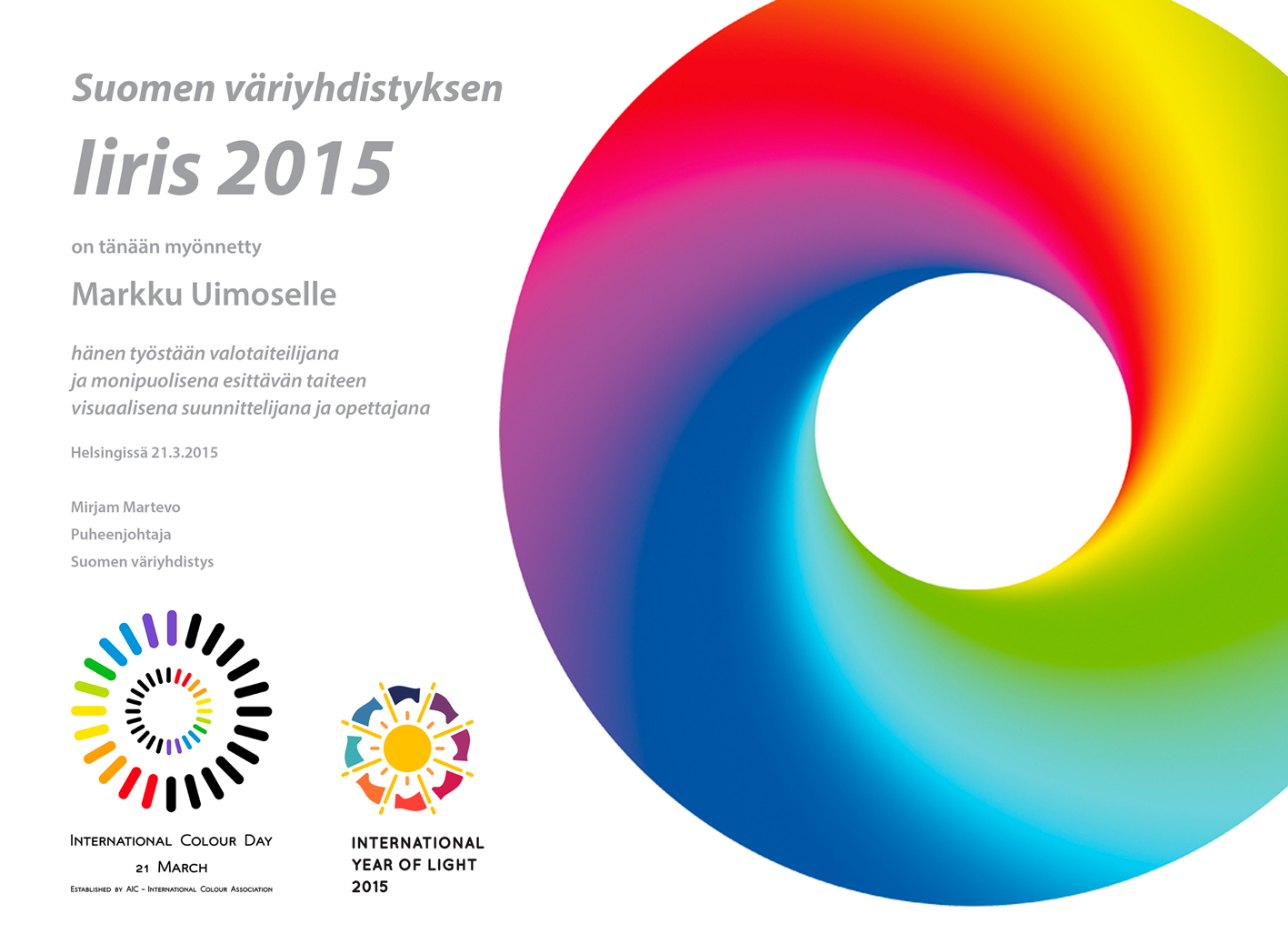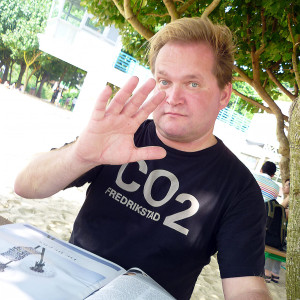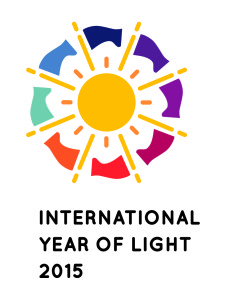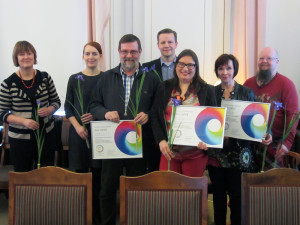
by Suomen väriyhdistys | Mar 21, 2015 | News
The Finnish Colour Association (Suomen väriyhdistys) celebrates International Colour Day, 21st March, by giving the Iris Award to lighting designer, scenographer Markku Uimonen for his outstanding career as a versatile visual designer and teacher in the field of the performing arts.

Markku Uimonen
AIC International Colour Association has proposed Spring Equinox (21st March) to be celebrated as International Colour Day (www.aic-colour.org). The purpose of the International Colour Day is to draw attention to colour as a phenomenon shared by all humanity and to highlight events and achievements in the field of colour. In addition The United Nations has declared 2015 International Year of Light (www.light2015.org).

Chamber opera “La Voix Humaine”, Savonlinna Opera Festival, 1993. Kaisa Hannula, soprano; Markus Lehtinen, conductor; Vilppu Kiljunen, director; Markku Uimonen, visual designer. Photo: Markku Uimonen.
Mr. Uimonen was educated in the Theatre Academy of Finland (Now part of the University of the Arts Helsinki), the Hong Kong Academy for Performing Arts, and MIT Center for Advanced Visual Studies in Massachusetts, USA.
Markku Uimonen has designed visuals for over 60 large-scale productions for e.g. the Finnish National Opera, Operá du Rhin Strasbourg, Opera di Cosenza, Savonlinna Opera Festival, and most of the major theatres in Finland. In Sweden he has designed in the mid 90’s sets, lighting, and projections for the Gothenburg Folk Theatre and Riksteatern in Stockholm. In Hong Kong he has designed sets, projections and lighting in several venues, most notably the Lyric Theatre at the Hong Kong Adacemy for Performing Arts HKAPA, where he has served as a visiting professor and Artist-in-Residence several times since 2002, latest being the spring semester 2013. Markku Uimonen was artistic director of the LUX Helsinki Light Art Festival 2011–2014
Other artistic work ranges from conceptual light art to contemporary theatre and from exhibition lighting (e.g Hannover Expo pavilion 2000) to numerous Contemporary Dance visualizations.

“4000V-Shadow of Light”. Acrylic, charcoal and neon light on canvas, 2014. Re-production of work exhibited at the Retretti Art Centre, 1995. Photo: Markku Uimonen.
Markku Uimonen’s contribution to teaching design in the performing arts is profound and extensive. He worked as lecturer in scenography at the University of Art and Design Helsinki (now Aalto University School of Arts, Design and Architecture) during 1997–99 and as professor of lighting design at the Theatre Academy of Finland from 2000 until the end of last year. He has also led numerous international lighting workshops, and has given talks in seminars and conferences in Sweden, France, USA, China, Japan and Russia.
The Finnish Colour Association’s Iris Award (Suomen väriyhdistyksen Iiris -palkinto) can be given to work or deed involving colour that has noticeably improved aesthetic appreciation, functionality or safety in people’s environment and daily life. The work can involve fine art, design, architecture or environmental design or for example colour technologies such as the printing industry.



by Suomen väriyhdistys | Mar 22, 2014 | News

Thorvald Lindqvist’s unique research from the 1980s provides Information about historical colours of Helsinki for today’s builders and restorers. Photo Helsinki City Building Supervision Office/Leena Jaskanen.
The Finnish Colour Association (Suomen väriyhdistys) celebrated International Colour Day, 21st March, by giving the Iris Award to the Helsinki City Building Supervision Office, Tikkurila Oyj and Metropolia University of Applied Sciences Degree Programme in Paper Conservation.
The award was given for their unique collaboration on reviving and saving for posterity the colour research of building conservator Thorvald Lindqvist. In the 1980s Lindqvist charted and collated facade colours of houses in Helsinki, representing building styles and periods from the Empire classical era to the 1960s. Lindqvist’s work was stored on the shelves of the Building Supervision Office as colour samples and notations in dozens of binders that were all but forgotten for three decades.
In 2012 the Building Supervision Office started a unique collaboration with the paint company Tikkurila to resurrect Thorvald Lindqvist’s historical colour plans. The project involved analysing Lindqvist’s notes and samples and converting them to present-day colour codes and tinting recipes, thus making them available to today’s planners, architects, builders.
‘The Helsinki Colour plan’ is an internet site, provided by the Building Supervision office, that makes these lost colours available again to all citizens. It includes scanned images of the original colour samples as well as a facade colour search functions by map, area, address and period. It also provides detailed advice and information on on methods and materials for repainting and resorting historical facade colours. See: (http://www.hel.fi/static/rakvv/varikaava/index.htm
Tikkurila’s contribution was to create the tinting recipes and new codes for Lindqvist’ colours, making them available to consumers and builders all over the country. In addition, Tikkurila set up an interactive web-service ‘Helsinki-värit’ (http://www.tikkurila.fi/helsinkivarit) that helps customers choose appropriate colour combinations for their colour restoration and repainting projects. The interactive service provides a digital colour chart and images of building styles, where the colours can be assigned according to Thorvald Lindqvist’s research findings.
Students of Metropolia University of Applied Sciences Degree Programme in Paper Conservation rounded off this multidisciplinary project in 2013 by conservating the original written pages and colour samples recorded by Thorvald Lindqvist, thus ensuring there availability to future researchers. ‘Helsingin värikaava’ was one of the World Design Capital Helsinki 2012.
Facade colours are among the most salient of urban visual elements. At the same time they are the most most vulnerable, both physically and culturally. The above project is an example of a joint effort to preserve an often neglected part the cultural history and ‘collective memory’ of our everyday surroundings. It is also an example of what can be achieved by open-minded collaboration between three distinctly different operators representing planning supervision, commerce and education.
Architects Leena Jaskanen and Marjatta Uusitalo together with their assistant, architecture student Anna Heikinheimo were responsible for the project at the Building Supervision Office. Design Manager Marika Raike, Customer Category Manager Marcus Wallström, Marketing Coordinator Rya Rosenlund-Tiainen and Tikkurila Color Service were the collaborators at Tikkurila Oyj. The conservation work at Metropolia University of Applied Sciences was done by students Jiri Taleva, Karoliina Valli and Hanna-Leena Väisänen under the supervision of lecturer Päivi Ukkonen.

From left to right: Marjukka Haavisto, Anna Heikinheimo and Olli Turunen (Helsinki City Building Supervision Office), Marcus Wallström and Marika Raike (Tikkurila Oyj), Päivi Ukkonen and Jiri Taleva (Metropolia).
Harald Arnkil
Chair, Iris Jury
Vice President, Finnish Colour Association
by Suomen väriyhdistys | Jan 3, 2014 | News
THE URBAN EVENT LUX HELSINKI OFFERS EXPERIENCES FOR ALL THE SENSES
The urban event Lux Helsinki offers experiences for all the senses during the darkest time of the year, from Saturday 4 January to Wednesday 8 January 2014. Visually spectacular light installations will entice people to spend time in the wintry outdoors of Helsinki.
An exciting and surprising route consisting of twelve installation sites will lead visitors along the shore of Töölönlahti bay, past the National Opera’s amphitheatre, Hesperia Park, the National Museum, the Hakasalmi Villa, Helsinki Music Centre, the old railway warehouses and Kansalaistori Park to the New Student House. The event’s central stage is Senate Square. TheLux Ratikka tram will also be returning to the tracks after its first appearance in 2013. Merikaapelihalli in the Cable Factory will host Lux IN, Lux Helsinki’s first exhibition of light art.
The installations, created by Finnish and international artists, can be viewed daily from 5 pm to 10 pm. Their durations vary, but they all operate on a continuous loop during the display hours. The Lux IN light art exhibition is open between 2 pm and 10 pm. Fire Circus Walkea will give performances daily at 6 pm and 7:30 pm.
The artistic director of the event is Markku Uimonen and technical director is Ilkka Paloniemi. Sun Effects Ltd is the producer of the event.
The Lux Helsinki event is organised by the City of Helsinki and the entry is free of charge.
SIDE PROGRAMME
On Wednesday 8 January, from 11 am to 7 pm, the Kiasma Theatre at the Museum of Contemporary Art Kiasma will host the international light art symposium Invisible Light. The symposium is open for everyone and the entry is free of charge. No preregistration is required. The language of the symposium is English.
The symposium explores light art. It concentrates on both artworks created by light and also seeing, experiencing and perceiving light. How to see and sense pure light without objects that reflect light? How to present pure light as an artwork? How light installations should be seen and experienced?
More information about the Side Programme and Symposium at: http://luxhelsinki.fi/en
by Suomen väriyhdistys | Oct 14, 2013 | News
Attached is an interesting article on a female colour researcher in Georgian era England. Written by Alexandra Loske, researcher at the Department of Art, University of Sussex, England. Sent by Robert Hirschler, chairman, SGCE (Study Group on Colour Education), International Colour Association AIC. Mary_Gartside_St_Andrews_final_for_research_pages

by Suomen väriyhdistys | Mar 21, 2013 | News

WHAT IS ICD?
The INTERNATIONAL COLOUR DAY was established by the AIC – International Colour Association. Celebration of the international day of light and colour on March 21st has spread throughout the AIC international network and is now supported by its members all over the world.
ICD – International Colour Day – was considered an appropriate recognition since, thanks to visual perception, colour is one of the most influential phenomena in our lives and is also a major contributor of our perception of reality.
Since light and colour are inseparable, ICD – International Colour Day – celebrates colour as well as light. Colour is always connected with light; without light there would be no colour.
Few things affect us as much as colour. It plays a vital part in the perception of our surroundings, whether at work, in public spaces or in our homes. Colour and light are such universal components of our existence that we don’t usually even give them a thought. All surfaces are coloured. Colour has an outstanding role in our society and it also tells us much about different cultures, being a crucial aspect in the ways we define our identity.
WHY MARCH 21st?
The proposal to establish an international colour day was made in 2008 by the Portuguese Colour Association – Associação Portuguesa da Cor APCOR – whose president Maria João Durão presented the idea to the International Colour Association. The proposal was approved in 2009 among the members of the AIC society, which is composed of national associations and members representing more than 30 countries.
The choice of date came after a good deal of discussion. Among all suggestions presented, the idea exposed by Leonhard Oberascher from Austria prevailed: the Spring equinox – aequus (equal) and nox (night) occurs around March 21st.
Around the equinox, night and day are approximately of equal length, symbolically relating to the complementary nature of light and darkness, light and shadow having their expressions in all human cultures.
LOGO
An international competition was held for the design of the logo, and the winner was announced at the meeting of the International Colour Association, AIC 2012 held in Taipei, Taiwan. The selected design was created by Hosanna Yau, from Kowloon, Hong Kong.
As expressed by designer Hosanna Yau: ”The two circles form an eye, equally combining the colours of the rainbow and black, representing light and darkness, day and night – everyone feasts one’s eye on the International Colour Day.”

The logo can be downloaded for use from the AIC website.










 English
English  Suomi
Suomi